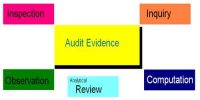Auditing Standards
Generally Accepted Auditing Standards or GAAS are sets of standards against which the quality of audits are performed and may be judged. Several organizations have developed such sets of principles, which vary by territory. The auditor must diligently perform the audit and report any misleading statements in the report.
ISA issues at present, International Standards on Auditing (ISAs) are professional standards that deal with the independent auditor’s responsibilities when conducting an audit of financial statements. ISAs contain objectives and requirements together with the application and other explanatory material. The auditor is required to have an understanding of the entire text of an ISA, including its application and other explanatory material, to understand its objectives and to apply its requirements properly –
(a) Audit committee guide impairment: ISA has released a guide with an overview of the key concepts of impairment testing and why it is important.
(b) New audit committee guide on integrated reporting: A new resource is available for audit committees to begin their integrated reporting journey.
(c) Assuring carbon emissions: ISA established a guide focuses on the importance of assuring greenhouse gas emissions and how to get the most value from it.
(d) Global Audit Committee guidance issued: A new report highlights the common challenges and opportunities faced by audit committees in Asia, Europe, and the US when meeting obligations to shareholders.
(e) Economy heightens the need for governance, risk, and compliance: This audit committee guide provides guidance to audit committees on how to evaluate and improve their risk and compliance processes.
(f) New audit committee guide on business valuation risk: The Institute’s latest audit committee guide provides information for directors on how to manage business valuation risk.
(g) A new guide on how to protect your organization from bribery and corruption: The Institute has published this guide for audit committees on identifying bribery and corruption risks and developing systems and measures for appropriately managing them.
(h) The benefit of audit: A guide to audit quality: The purpose of this guide is to enhance the communication between an audit committee and the external auditor.
(i) Concise Guide to Treasury Risk Management: The Institute has developed this guide for senior management and audit committees















